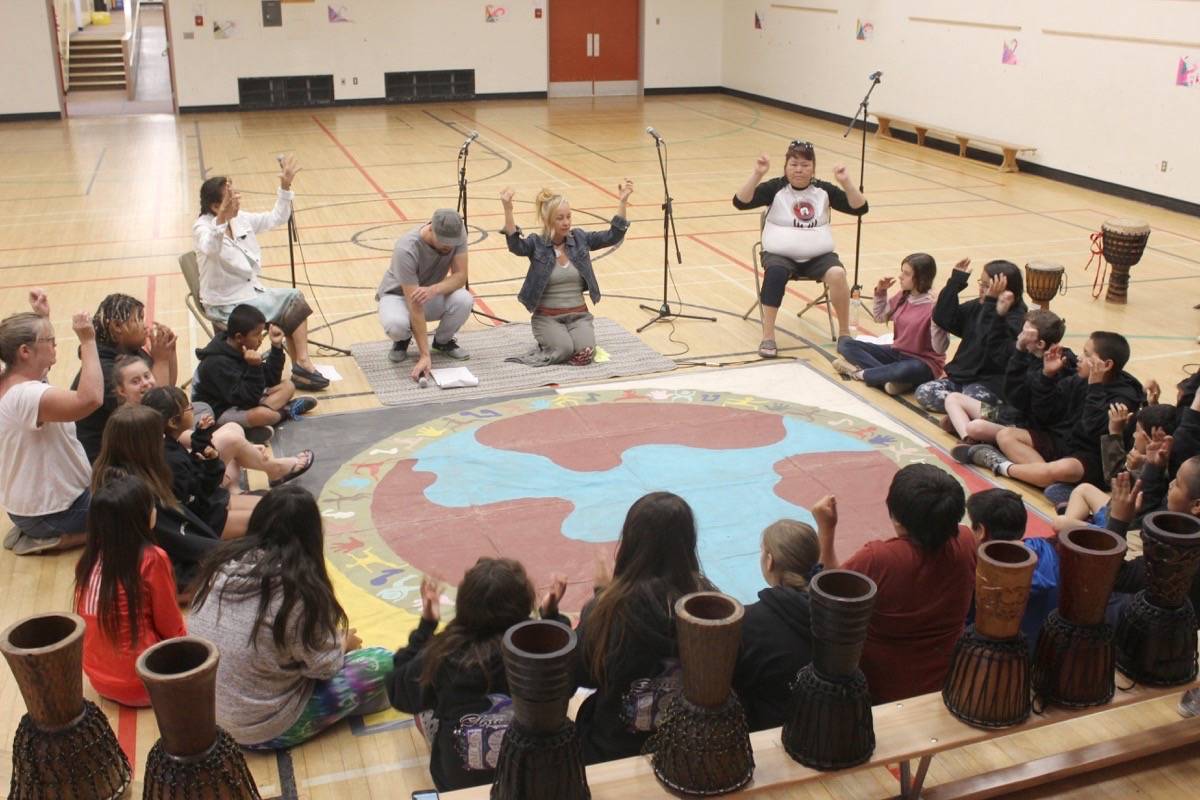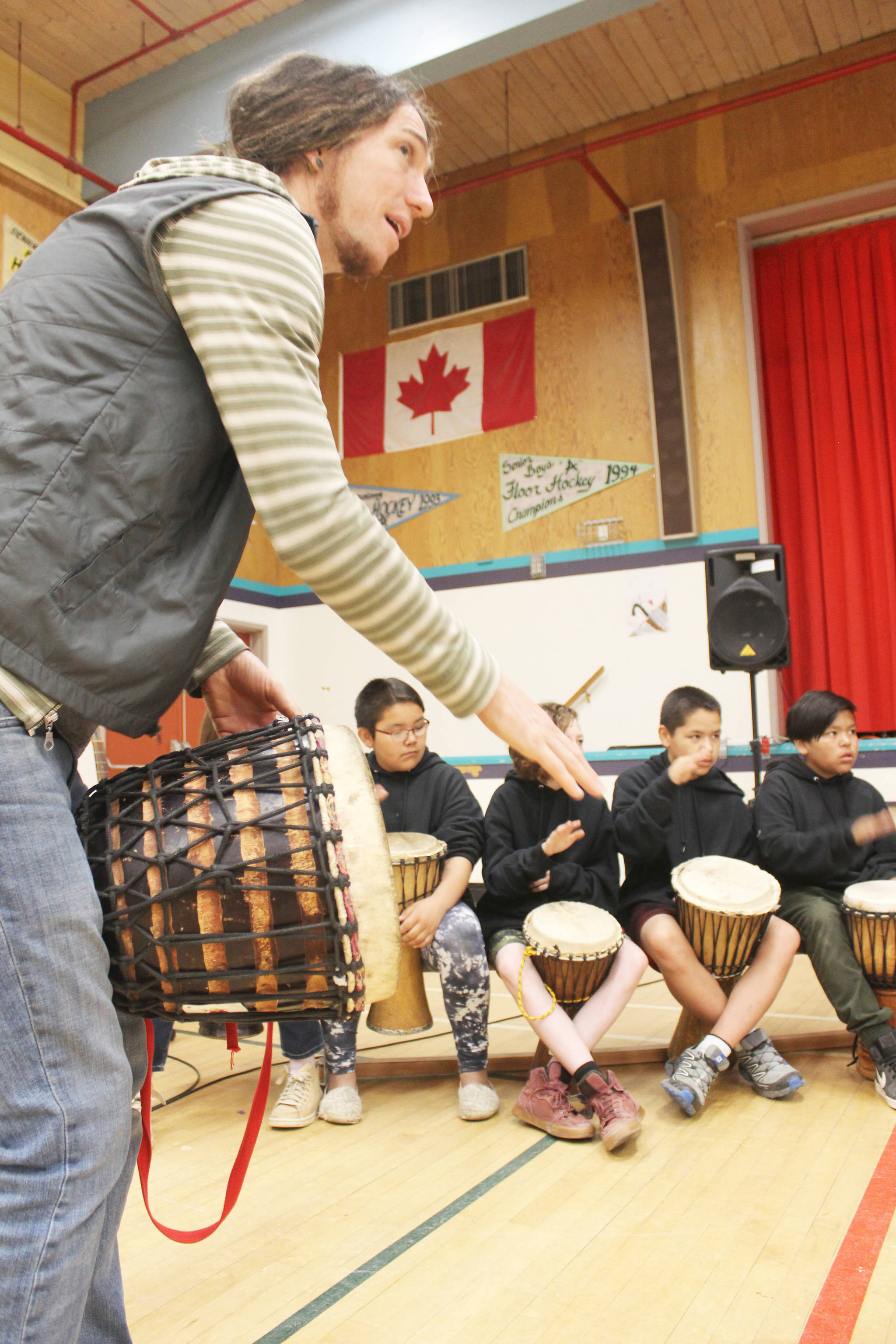A group of students at Marie Sharpe Elementary School each pick up a West African drum, having just congo-lined their way to their seats. They look curiously at the instruments, which come in several sizes, before a facilitator explains and demonstrates how to hold them.
Five minutes later, the students have already learned how to properly strike the drums in two different ways, and are well on their way to learning a new rhythm.
The class is part of an artist residency called Freedom Arts.
“We are using rhythm, movement, song and songwriting, and kinesiology as a pathway through music to connect with children and youth to nurture emotional and social wellness,” said workshop facilitator Angela Roy.
Roy and her two band mates, Dan Loewen and Blake McAndless, of Barefoot Caravan, are on their sixth week of residencies in schools, their second in Williams Lake. Last week, the group did a similar residency with Nesika and Lake City Secondary students.
“It’s not focusing on the skill or abilities, it is focusing on using musical approaches to nurture classroom culture, classroom community, and peer bonding,” said Roy.
After the students had learned the different drum strokes, she lead them in a name rhythm game, and then into learning two different drum beats.
Then, with the help of the school’s language teachers, the group started work on learning the basics of songwriting by taking a song Roy had started, and adding sections in both Shuswap and Chilcotin.
Incorporating local languages into the workshops and songs is something Roy said is important.
“If you are connected with family and culture and language, your nation, your tribe, your clan, you are going to survive, you are going to thrive,” she said.
“It’s the fusion of tradition to current modern expressions of culture. If we can start fusing that and empower the youth to take back those teachings, but bring them through a way that might look different.”
While she said she uses the word fusion with some caution, she points to the band A Tribe Called Red as an example of a group doing that remarkably well.
“The main thing is we work a lot with the principle of Indigenous music and Indigenous and First Nation cultures from around the world, Canadians, South Americans, Africans, and working with the idea that before music was notated, everyone used music and art to celebrate the ‘vie quotidienne,’ domestic life.
“Somewhere along history there became a division between musician and audience, observer and somehow a lot of people get the message that they are not singers, they are not drummers, they are not dancers.”
Related: Band program gets $10,000 grant
It’s something Roy hopes to change through her messaging to students.
“If you can talk you can sing,” she told students as they started the workshop.
“Our main initiative is to engage, empower and connect the youth to the idea that they own music. They have a right to whatever skill level they are. They can use music as a process to emotional and social wellness and wealth.”
The group tailors their teachings to the level and ability of students — they’re also piloting a program with students from the secondary school to help and co-facilitate some of their classes with the younger students.
“One of the awesome parts of this program is as we are working with the classrooms made of diverse people of many different levels, we get some one-on-one time to work with people who already have instrument skills, we get to teach people who are interested in their sound gear about how to put all that together, we get to teach kids about song writing and that’s something they can take into their own lives, but we do it as a class project. It’s something that is really rewarding,” said Loewen.
The incorporation of music and rhythm is also something Roy hopes teachers are able to take back into the classroom.
“You get all your brain involved in learning,” she said, adding she hopes some of the classes will make that connection for teachers.
“We try to expose them to as many things as possible, whether it is culture or music,” said Marie Sharpe principal Calvin Dubrey, adding that as a trauma-informed school, music is one of the ways they provide for students to centre, calm and ground themselves.
“It allows some of our vulnerable kids who might not get the opportunity to participate in things like that to have that chance to, and to see if that is something they really enjoy to see, whether that is something they want to pursue in the future,” he said.
Locals can get a taste of what the residency has been like at a concert this Saturday at Boitanio Park.
A fundraiser for Marie Sharpe Elementary, the event will start at 3:30 p.m. with a movement and rhythm workshop, followed by a local display of performing artists. Students from Lake City Secondary and the French immersion programs will be performing, as will Francis Johnson and the Marie Sharpe hoop dancers. The concert will end with the trio set of Barefoot Caravan performing, beginning at 6:30 p.m.
Related: Marie Sharpe hoop dancers perform for First Nation Role Model candidates

